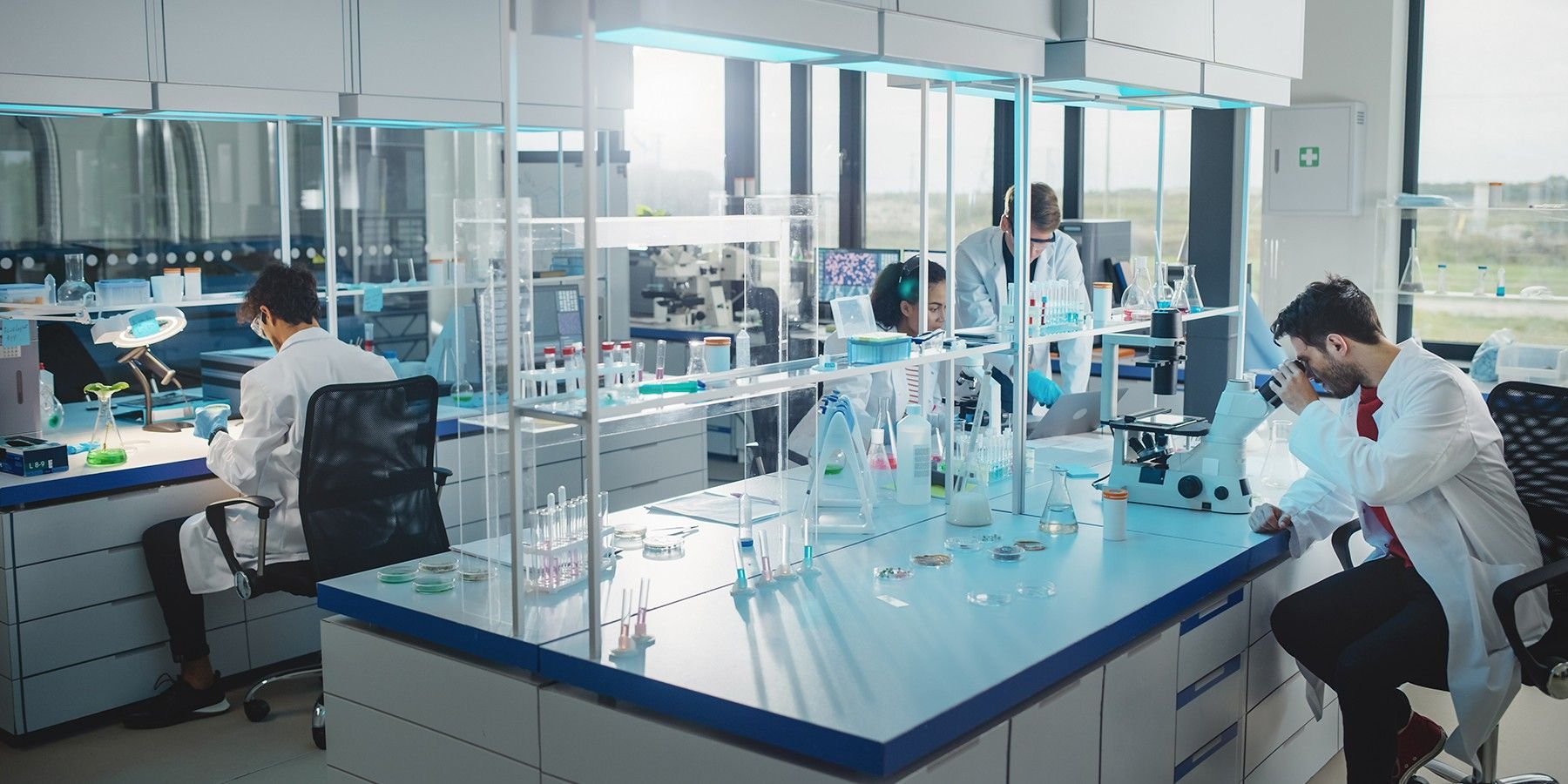Lab Design for the Future: Balancing Flexibility, Sustainability, and Collaboration
Liam Brown, principal with mcCallumSather
In recent years, laboratory design has seen a transformative shift driven by the growing demand for high-performance research environments that are adaptable, sustainable, and collaborative. With advancements in science and technology progressing rapidly, the need for flexible and innovative lab spaces has never been greater.
Mary Georgious, principal, mechanical lead with mcCallumSather
Lab Design News spoke to Liam Brown, principal, and Mary Georgious, principal, mechanical lead, both with mcCallumSather, about how integrating state-of-the-art technologies with sustainable design helps meet the evolving needs of both academic and research institutions. Drawing from their work at the University of Waterloo, Brock University, and beyond, their experience exemplifies how thoughtful design can enhance scientific research, promote collaboration, and optimize long-term operational efficiency.
The evolution of flexible lab design
Historically, laboratory designs were tailored to specific research needs, resulting in highly customized and compartmentalized spaces. However, with the rise of interdisciplinary research and rapid technological advancements, these traditional designs often became outdated and inefficient. As research needs shift, so must the spaces where this research occurs.
mcCallumSather’s approach to lab design focuses on creating flexible environments that can be easily reconfigured as scientific priorities evolve—”whether that's opening up floor plans with services delivered from above, whether it's multiple control points to cap and modify systems, or whether it's decoupling storage from work surfaces,” says Brown. By implementing services delivered from above, such as control points for modifying systems, labs can adapt to future changes in research without costly overhauls. This flexibility is crucial, especially in research environments where capital dollars are often limited and priorities can change rapidly.
In their recent projects at the University of Waterloo and Brock University, mcCallumSather has demonstrated how open layouts foster interdisciplinary collaboration by removing barriers between research groups. At the University of Waterloo, the firm transformed traditionally compartmentalized spaces into expansive labs. “We switched from a double-loaded corridor to a single-loaded one, which meant more expansive labs,” says Brown. This design not only opened up the space for collaboration but also allowed for the strategic placement of fire compartments to maintain safety while encouraging openness.
Georgious adds, “Traditionally, you've got the double-loaded corridors where most of your shafts and the surfaces from floors above rise and then hit your penthouses or the roof spaces. Now, by shifting the corridor to single-loaded corridor out to get more sunlight, you now have to get a little bit more creative on where you're going to lay out your big pieces of equipment that require the biggest pieces of ductwork and exhaust associated with it.
She continues, “We had to collaborate and work really closely [with the project team] to find the most optimal spot to tuck most of those services from the levels below us all the way up.”
Interdisciplinary collaboration: the new norm in lab design
Designed to inspire innovation, labs prioritize interdisciplinary collaboration, blending open spaces, advanced tools, and seamless design to foster connections and spark new ideas.
Collaboration is key in modern research, and mcCallumSather’s designs reflect this priority. At Brock University, the firm created a lab environment that encourages collaboration between academia and industry. The space includes demonstration labs where industry partners can showcase their equipment, as well as fully equipped labs where students can learn how to use the tools they will encounter in the professional world. This model not only supports education but also strengthens ties between academic research and industry innovation.
At the heart of mcCallumSather’s design philosophy is the belief that interdisciplinary collaboration should be woven into the physical structure of the lab. By creating open, shared spaces where researchers from different disciplines can interact, the firm fosters environments where new ideas can emerge organically. These spaces often include strategic use of natural light and visual access to research activities, which can inspire curiosity and engagement from both researchers and visitors.
Georgious highlights the importance of close collaboration between architects and engineers during the design process. She adds,”The contractor is an integral team member to the success of how these projects actually come together.” By working together from the outset, the team can ensure that mechanical systems, such as ductwork and HVAC, are integrated seamlessly into the design, maximizing both functionality and aesthetics. The firm’s interdisciplinary approach ensures that no aspect of the design is an afterthought and that the needs of the researchers are always prioritized.
She also points out the usefulness of design tools such as Navisworks, a 3D design review software program that allows the project team to work together in real-time to develop a lab project. “There have been a lot of times where Liam and his team would be sketching things on paper and [would say], ‘We were thinking about putting the hoods here. What do you think? Should we move them here? Should we shift them there?’” She continues, We're able, before we develop the design even further, to have these conversations—do we want the services from the bottom, or do we want the services from the top, and why? Which is a better solution? So early on, we're able to have this conversation internally and then translate it to the client and hear from them as well.”
Sustainability: a core element of modern lab design
Sustainability is another key factor driving the evolution of lab design. Laboratories are notorious energy hogs, especially in fields like chemistry, where high air-change rates and fume hoods contribute to significant energy consumption. mcCallumSather is committed to reducing the environmental impact of labs by incorporating energy-efficient systems and sustainable materials into their designs.
One example of this commitment is the University of Waterloo’s lab renovation project, where the firm introduced an innovative heat pump system for heating and cooling. This system mimics the performance of a geothermal field by utilizing the university’s central plant and heat exchangers to create a condenser loop. This solution not only improves energy efficiency but also sets the university up for future decarbonization efforts by allowing it to transition to a more sustainable system without major infrastructure changes.
In addition to mechanical systems, mcCallumSather is mindful of the materials used in lab construction. Wherever possible, the firm reuses existing structures to minimize embodied carbon, reducing the environmental impact of new construction. For example, rubber flooring and other sustainable materials are often incorporated into their designs, further contributing to the long-term sustainability of the lab environment.
Balancing technology with adaptability
Modern lab design integrates cutting-edge technologies like vertical lift modules and robotic systems, creating efficient, flexible spaces ready to meet the demands of future research. Design software also allows project team members to collaborate smoothly.
One of the biggest challenges in lab design is finding the balance between integrating advanced technologies and maintaining adaptability for future needs. As scientific research becomes increasingly complex, labs must be equipped with cutting-edge tools and systems while still remaining flexible enough to accommodate future advancements.
mcCallumSather is addressing this challenge by exploring innovative solutions such as vertical lift modules (VLMs), which maximize the use of vertical space. VLMs act as a “carousel of science,” allowing equipment and workstations to be stored vertically and accessed as needed. This not only saves valuable floor space but also makes the lab environment more adaptable to changing research needs. These systems can even span multiple floors, further enhancing their utility in space-constrained labs.
“You can have them spanning multiple floors as well, which is super cool because then you can have dry chemical storage on the ground floor in a carousel that's coming up and accessed in multiple levels of the lab,” says Brown of the VLMs. “I'm looking forward to what the future of lab design holds as it relates to those types of systems.”
Another exciting development is the rise of self-driven laboratories, where robotic collaborators perform tasks traditionally handled by human researchers. mcCallumSather’s design for a new lab at the University of Toronto incorporates this technology, creating an environment where science can be conducted more efficiently and with fewer personnel on-site. This trend is likely to grow in the coming years as automation becomes more prevalent in research.
Looking ahead: the future of lab design
As we look to the future, the role of technology and sustainability in lab design will continue to expand. On the firm’s radar right now, says Brown, are mobile collaborators, robotics, and self-driven laboratories. “[We have] an eye on getting people out of the labs and delivering science an order of magnitude faster than it's being done now. That's super exciting, and I think it’s a trend that we'll continue to see grow,” he says.
“The technology on the mechanical side is evolving and changing and progressing every day, and we are trying to keep up with all of it,” adds Georgious.
Modular lab facilities, off-grid solutions, and mass timber construction are also emerging trends that mcCallumSather is actively exploring. These innovations offer exciting possibilities for creating lab spaces that are not only more sustainable but also more adaptable to the changing needs of the research community. Mass timber, in particular, is gaining traction as a sustainable construction material. While its porous nature presents challenges in laboratory environments, mcCallumSather is experimenting with ways to expose the wood strategically, creating a warm, inviting atmosphere without compromising safety or functionality.
mcCallumSather’s approach to lab design is a forward-thinking blend of flexibility, sustainability, and interdisciplinary collaboration. By prioritizing adaptability and energy efficiency, the firm is setting a new standard for the labs of the future, with research environments that are not only efficient and productive but also inspiring spaces where science can thrive.




